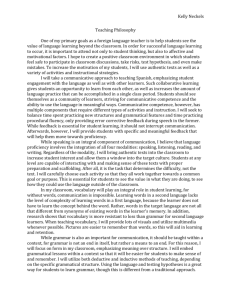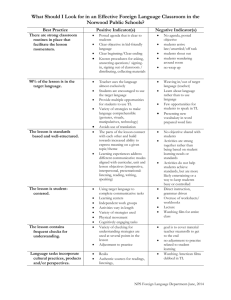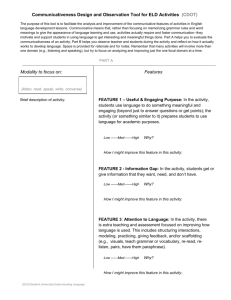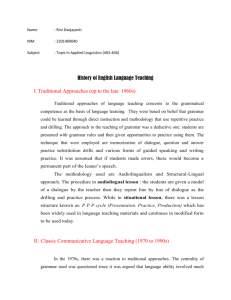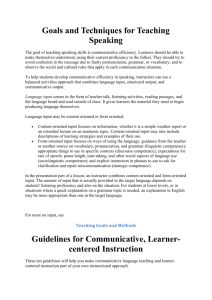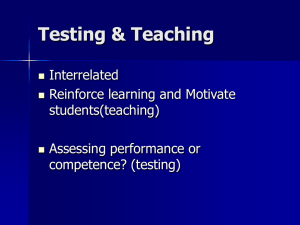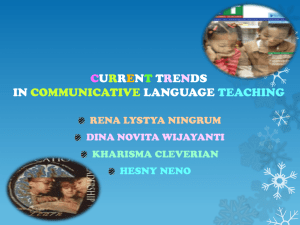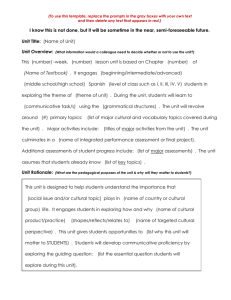Statement-of-Teaching-Philosophy
advertisement
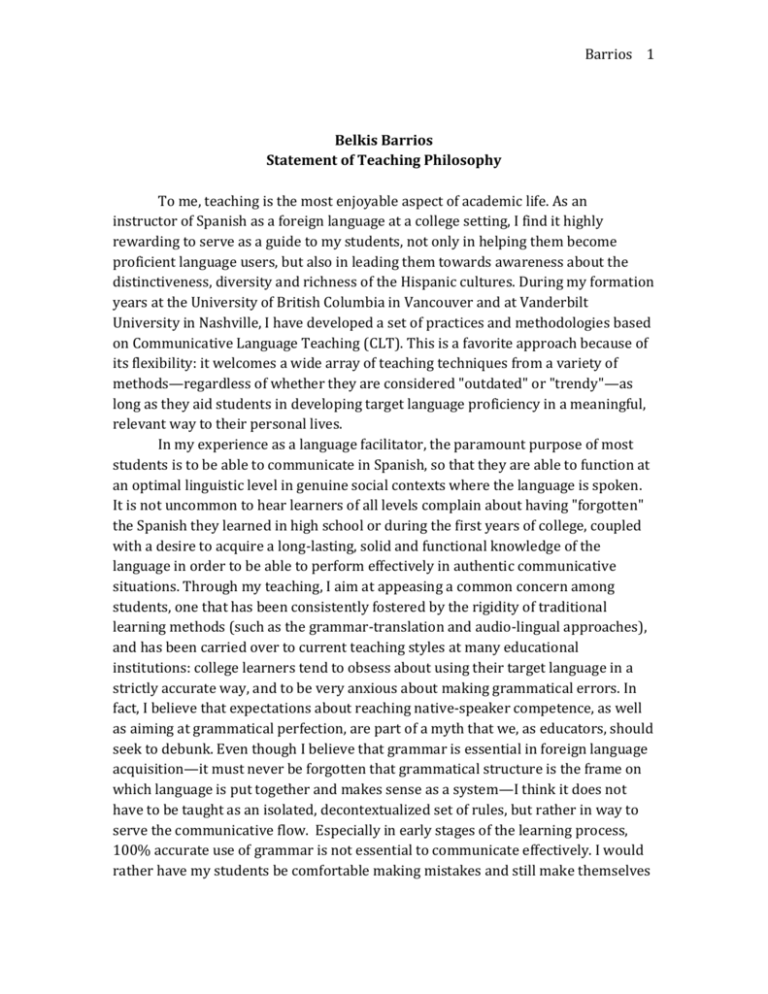
Barrios 1 Belkis Barrios Statement of Teaching Philosophy To me, teaching is the most enjoyable aspect of academic life. As an instructor of Spanish as a foreign language at a college setting, I find it highly rewarding to serve as a guide to my students, not only in helping them become proficient language users, but also in leading them towards awareness about the distinctiveness, diversity and richness of the Hispanic cultures. During my formation years at the University of British Columbia in Vancouver and at Vanderbilt University in Nashville, I have developed a set of practices and methodologies based on Communicative Language Teaching (CLT). This is a favorite approach because of its flexibility: it welcomes a wide array of teaching techniques from a variety of methods—regardless of whether they are considered "outdated" or "trendy"—as long as they aid students in developing target language proficiency in a meaningful, relevant way to their personal lives. In my experience as a language facilitator, the paramount purpose of most students is to be able to communicate in Spanish, so that they are able to function at an optimal linguistic level in genuine social contexts where the language is spoken. It is not uncommon to hear learners of all levels complain about having "forgotten" the Spanish they learned in high school or during the first years of college, coupled with a desire to acquire a long-lasting, solid and functional knowledge of the language in order to be able to perform effectively in authentic communicative situations. Through my teaching, I aim at appeasing a common concern among students, one that has been consistently fostered by the rigidity of traditional learning methods (such as the grammar-translation and audio-lingual approaches), and has been carried over to current teaching styles at many educational institutions: college learners tend to obsess about using their target language in a strictly accurate way, and to be very anxious about making grammatical errors. In fact, I believe that expectations about reaching native-speaker competence, as well as aiming at grammatical perfection, are part of a myth that we, as educators, should seek to debunk. Even though I believe that grammar is essential in foreign language acquisition—it must never be forgotten that grammatical structure is the frame on which language is put together and makes sense as a system—I think it does not have to be taught as an isolated, decontextualized set of rules, but rather in way to serve the communicative flow. Especially in early stages of the learning process, 100% accurate use of grammar is not essential to communicate effectively. I would rather have my students be comfortable making mistakes and still make themselves Barrios 2 understood by native or proficient second language speakers of Spanish in an authentic context. In this vein of thought, I believe that grammar forms can be presented to students embedded as they occur in meaningful communicative scenarios, in other words, following an inductive approach. Likewise, I think that any communicative material or task- based situation allow for a new grammar structure to be introduced to students. Indirect object pronouns, for example, might be thought as an abstract grammar rule that is difficult to grasp without an initial deductive explanation. However, as opposed to starting a class stating the rule and following with an example, I usually choose to start with a relevant, contextual demonstration by asking students to hand each other several classroom objects. As a student gives a book to a peer, I say out loud and write on the board: "X le da el libro a X," (X gives the book to X"), slowing down, raising my voice and using body language to indicate motion (giving something to somebody) as I pronounce the indirect object pronoun "le." It is only after repeating the same procedure with several objects and several students when I focus with more formal detail on how the general rule operates and, for that, I use concrete examples previously generated by the students themselves through real interaction. Teaching abundant and diverse vocabulary is another key component of my teaching methods. From my experience, students are always motivated to learn words, and they understand that this is as a powerful way to expand their communicative potential. In my view, it is pointless to have students master grammar if they are not capable of filling “gaps” of meaning, which can only be supplied by lexicon. A student who is successful in recalling and using grammar rules but who has a limited knowledge of vocabulary will be linguistically “handicapped” in any authentic communicative situation, missing out on an organic and creative component essential to any language: the ability to name things and combine different words effectively for a more enriching and meaningful language experience. I also value the affective filters that influence learning. Target language proficiency is best achieved in a positive, fun, relaxed and empathetic classroom environment, where learners do not feel anxious to talk and make errors. This is essential because, in my view, pair and group work is a powerful way to foster meaningful communication. One of the principles of Communicative Language Teaching is to promote cooperative and collaborative learning. By being engaged in collective language tasks, students get exposed to each other's experience and expertise which is, in itself, enriching and fruitful. In order to achieve comprehension and negotiate meaning, learners constantly need to reformulate their utterances until their peers can fully understand what they are attempting to communicate. Barrios 3 As I mentioned in the introductory paragraphs, not only do I lead my students to an optimal use of their target language, but also I try to foster understanding about culture. In order to achieve this goal, I always keep in mind the five "C's" contemplated by the ACTFL Standards (Communication, Cultures, Comparisons, Connections and Communities). I believe that being able to communicate in more than one language broadens the learners' functionality in a variety of situations, enriches their perspectives on diversity by encouraging meaningful comparisons between other cultures and their own, promotes connections with other disciplines, and, most importantly, in a globalized world where geopolitical borders tend to erase, allows learners to actively participate in multilingual communities, both locally and internationally. Following this line of thought, I am aware of how important the use of authentic cultural materials is in the second language classroom. Therefore, in each one of my classes I make use of multimedia technology to share a diverse array of materials with my learners (youtube videos, movies, music, TV news, talk shows, newspaper articles, entertainment / sports websites, tailored Power Point presentations, etc.). Not only do students enjoy these materials, but also they appreciate the meaningful link between their contents and the "reality" associated with the Spanish-speaking world. Being exposed to different types of cultural expressions and artifacts, well beyond the textbook, provides learners with an opportunity to grasp important aspects of the Hispanic culture and, in doing so, they become not only more culturally aware but also more naturally proficient in their performance of the target language. To summarize, Spanish is not a subject that is learned passively. That is why I design lesson plans that are fun and interesting and promote constant interaction between learners. I believe that my enthusiastic and interactive approach to teaching Spanish allows students to learn the language while being interested in the subject. My students can tell how much I enjoy teaching them, which in turn triggers their motivation to learn this wonderful language.
